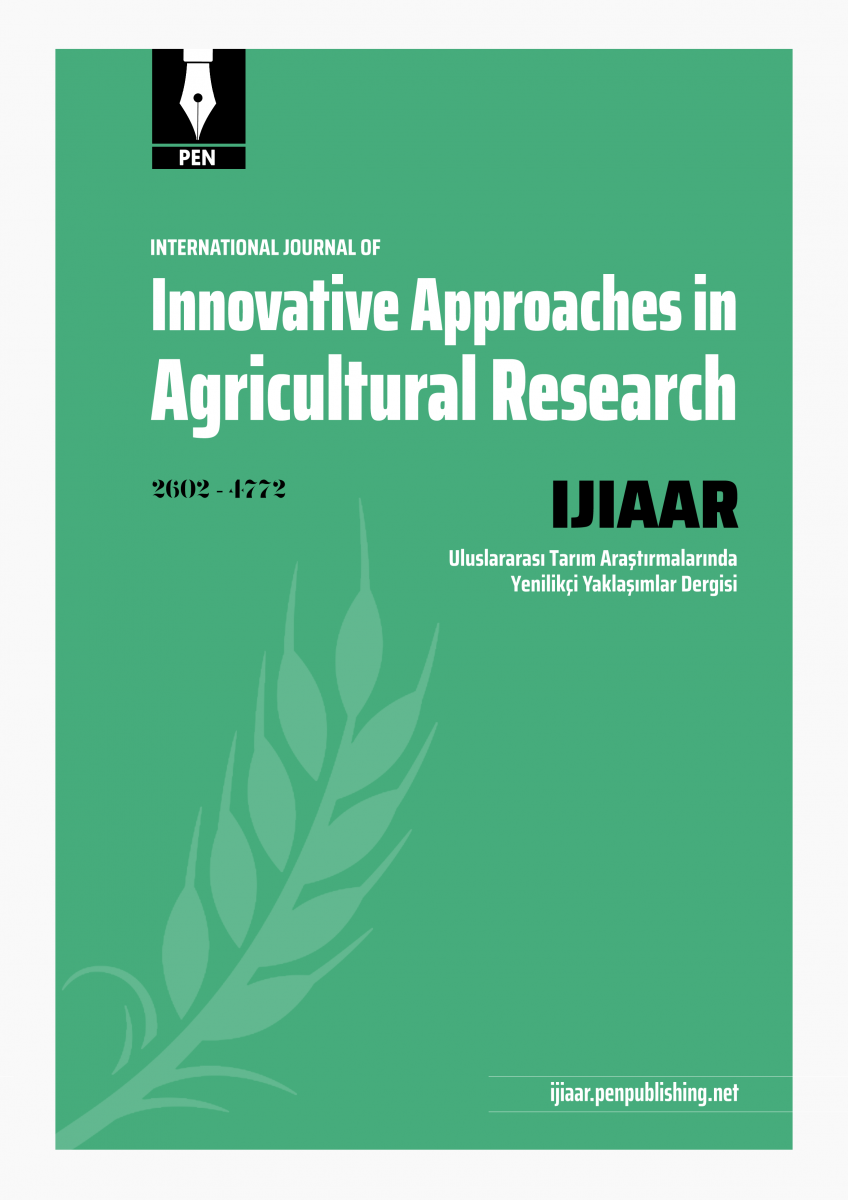- Abbott, W. S. (1925). A Method of computing the effectiveness of an insecticide. J. Econ. Entomol., 18, 265-267. [Google Scholar]
- Abdel-Baky, N. F. and A.H. Abdel-Salam (2003). Natural incidence of Cladosporium spp. as a bio-control agent against whiteflies and aphids in Egypt. J. Appl. Entomol., 127 (4), 228–235. [Google Scholar]
- Abdel-Baky, N. F., Arafat, S. Nehal and A.H. Abdel-Salam (1998). Three Cladosporium spp. as promising biological control candidates for controlling whiteflies (Bemisia spp.) in Egypt. Pak. J. Biol. Sci., 1, 188-195. [Google Scholar]
- Barta, M. and L. Cagan (2006). Aphid-pathogenic Entomophthorales (their taxonomy, biology and ecology). Biologia, 61, 543-616. [Google Scholar]
- Bensaci, O. A., H. Daoud, N. Lombarkia and K. Rouabah (2015). Formulation of the endophytic fungus Cladosporium oxysporum Berk. & M.A. Curtis, isolated from Euphorbia bupleuroides subsp. luteola, as a new biocontrol tool against the black bean aphid (Aphis fabae Scop.). J. Plant Prot. Res. 55, 80-87. [Google Scholar]
- Blackman, R. L. and V. F. Eastop (2000). Aphids on the World’s Crops: An Identification and Information Guide. John Wiley & Sons, Chichester, England, 476 pp. [Google Scholar]
- Burges, H. D. (1981). Safety, safety testing and quality control of microbial pesticides. In: Burges HD, editor. Microbial control of pests and plant diseases 1970-1980. London: Academic Press, pp. 737-767. [Google Scholar]
- Butt, T. M., L. Ibrahim, B.V. Ball and S. J. Clark (1994). Pathogenicity of the entomogenous fungi Metarhizium anisopliae and Beauveria bassiana against crucifer pests and the honey bee. Biocont. Sci. Technol., 4, 207-214. [Google Scholar]
- Carruthers, RI and Soper RS. 1987. Fungal diseases. In Epizootiology of Insect Diseases, J. R. Fuxa and Y. Tanada, eds.; New York: John Wiley and Sons. [Google Scholar]
- Carter, N., I. F.G. McLean, A. D. Watt and A.F.G. Dixon (1980). Cereal aphids: a case study and review. In: Coaker T.H. (ed.): Applied Biology. Acad. Press, London, 271–348. [Google Scholar]
- Chavan, B.P., J. R. Kadam and Y. S. Saindane (2008). Bioefficacy of liquid formulation of Verticillium lecanii against aphid (Aphis gossypii). Int. J. Plant Prot., 1(2), 69-72. [Google Scholar]
- De Faria, M. R. and S. P. Wraight (2007). Mycoinsecticides and Mycoacaricides: a comprehensive list with worldwide coverage and international classification of formulation types. Biol. Cont., 43, 237-256. [Google Scholar]
- Dixon, A. F. G. (1987). Cereal aphids as an applied problem. Agric. Zool. Rev., 2 (1), 1−57. [Google Scholar]
- Ehrlich, K. C. (2014). Non-aflatoxigenic Aspergillus flavus to prevent aflatoxin contamination in crops: advantages and limitations. Front Microbiol., 5, 50. [Google Scholar]
- Freed, S., F. L. Jin, M. Naeem, S.X. Ren and M. Hussian (2012). Toxicity of proteins secreted by entomopathogenic fungi against Plutella xylostella (Lepidoptera: Plutellidae). Int. J. Agric. Biol., 14, 291-295. [Google Scholar]
- Ganassi, S., A. Moretti, C. Stornelli, B. Fratello, A.M. Pagliai and A. Logrieco (2001). Effect of Fusarium, Paecilomyces and Trichoderma formulations against aphid Schizaphis graminum. Mycopathologia, 151, 131–138. [Google Scholar]
- Gibbons, J. G. and A. Rokas (2012). The function and evolution of the Aspergillus genome. Trends Microbiol., 21, 14-22. [Google Scholar]
- Gillespie, A.T. and E. R. Moorhouse (1989). The Use of Fungi to Control Pest of Agricultural and Horticultural Importance. In: Biotechnology of Fungi for Improvement of Plant Growth. (Eds.: Whipps. et. al.). London: Cambridge University Press, pp. 55-84. [Google Scholar]
- Glare, T., J. Caradus, W. Gelernter, T. Jackson, N. Keyhani, J. Köhl, P. Marrone, L. Morin and A. Stewart (2012). Have biopesticides come of age? Trends Biotechnol., 30, 250–258. [Google Scholar]
- Guesmi-Jouini, J., N. Boughalleb-M´hamdi and M. Ben Halima-Kamel (2010). Etudes préliminaires sur les champignons entomopathogènes des pucerons de l’artichaut en Tunisie. Entomologie faunistique – Faunistic Entomology. 63 (3), 171-181. [Google Scholar]
- Han, B., H. Zhang and L. Cui (1997). Epizootic infection and spatial pattern within epizootic peak period of Cladosporium sp. to the population of Aleurocanthus spiniferus. Entomol. J. East China, 40, 66-70. [Google Scholar]
- Hesketh, H., P. G. Alderson, B. J. Pye and J. K. Pell (2008). The development and multiple uses of a standardized bioassay method to select hypocerealean fungi for biological control of aphids. Biol. Cont., 46, 242-255. [Google Scholar]
- Hulden, L. (1986). The whiteflies (Homoptera, Aleyrododea) and their parasites in Finland. Notulae Entomol., 66, 1-40. [Google Scholar]
- Humber, R. A. (1991). Fungal pathogens of aphids, pp. 45–56. In: Peters, D.C., Webster, J.A. & Chlouber, C.S. (eds). Aphid-plant interactions: Populations to molecules, Agricultural Experiment Station, Division of Agriculture, Oklahoma State University, Stillwater. [Google Scholar]
- Kim, J.J., J. Gayoung, J. H. Han and S.Y. Lee (2013). Biological Control Aphids Using Fungal Culture and Culture filtrates of Beauveria bassiana. Microbiol, 41, 221–224. [Google Scholar]
- Lacey, L.A. and M. S. Goettel (1995). Current developments in microbial control of insect pests and prospects for the early 21st century. Entomophaga. 40, 3-27. [Google Scholar]
- Mburu, D. M., L. Ochola, N. K. Maniania, P. G. N. Njagi, L. M. Gitonga, M.W. Ndung’u, A. K. Wanjoya and A. Hassanali (2009). Relationship between virulence and repellency of entomopathogenic isolates of Metarhizium anisopliae and Beauveria bassiana to the termite Macrotermes michaelseni. J. Insect Physiol., 55, 774-780. [Google Scholar]
- McCoy, C.W., R. A. Samson and D.G. Boucias (1988). Entomogenous Fungi. In: Handbook of Natural Pesticides: Microorganisms. (Eds.: Ignoffo et.al.). CRC Press, pp. 260. [Google Scholar]
- Meyling, N.V. and J. Eilenberg (2007). Ecology of the entomopathogenic fungi Beauveria bassiana and Metarhizium anisopliae in temperate agroecosystems: potential for conservation biological control. Biol. Control, 43, 145-155. [Google Scholar]
- Milner, R. J. (1997). Prospects for biopesticides for aphid control. Entomophaga, 42, 227–239. [Google Scholar]
- Murerwa, P., A. P. Futi, K. A. Wanjiku and N. K. Maniania (2014). Effect of infection by Metarhizium anisopliae isolate ICIPE 51 on developmental stage, fecundity and intrinsic rate of increase of Rhopalosiphum padi and Metopolophium dirhodum. J. Entomol. Nematol., 6(11), 154-160 . [Google Scholar]
- Omar, A., I. Abdul-Wahid and S. M. Elbanna (2012). Evaluation of the insecticidal activity of Fusarium solani and Trichoderma harzianum against cockroaches; Periplaneta Americana. Afr. J. Microbiol. Res., 6(5), 1024-1032. [Google Scholar]
- Pan, W.Y., S. L. Chen, J. H. Lian, H. Z. Qiu and G. Lan (1989). A preliminary report on control of Hemiberlesia pitysophila using Cladosporium cladosporioides. For. Pest Dis., (3), 22-23. [Google Scholar]
- Rassipour, A., G. Radjabi and M. Esmaili (1996). Part II – Country Reports. Sunn Pests and Their Control in the Near East. 1996; http://www.fao.org/docrep/v9976e/v9976e05.htm. [Google Scholar]
- Remaudière, G., J. P. Latge and M. F. Michel (1981). Ecologie comparée des Entomophthoracées pathogènes de Pucerons en France littorale et continentale. Entomophaga, 26, 157-178. [Google Scholar]
- Roberts, D.W. and R. A. Humber (1981). Entomogenous Fungi. In: Biology of Conidial Fungi, Cole, G.T. and B. Kendrick (Eds.). Academic Press, New York, pp: 201-236. [Google Scholar]
- Saranya, S., R. Ushakumari, S. Jacob, Babu M. Philip (2008). Efficacy of different entomopathogenic fungi against cowpea aphid, Aphis craccivora (Koch). J. Biopest., 3 (1 Special Issue) 138 - 142. [Google Scholar]
- Seye, F., T. Bawin, S. Boukraa, J. Y. Zimmer, M. Ndiaye, F. Delvigne and F. Francis (2014). Effect of entomopathogenic Aspergillus strains against the pea aphid, Acyrthosiphon pisum (Hemiptera: Aphididae). Appl. Entomol. Zool., 49, 453–458. [Google Scholar]
- Shah, P. A. and J. K. Pell (2003). Enthompathogenic fungi as biological control agents. Appl. Microbiol. Biotechnol., 61, 413-423. [Google Scholar]
- Tell, L. A. (2005). Aspergillosis in mammals and birds: impact onveterinary medicine. Med. Mycol., 43, S71–S73. [Google Scholar]
- Thumar, R. K. and M. N. Kapadia (1994). Ovicidal control of Aleurolobus barodensis (Maskell) and its suppression by the entomopthogenic fungus. Indian Sugar, 44, 501-502. [Google Scholar]
- Won, W. L., Y. S. Tae, M. B. Sung and D. W. Soo (2015). Screening and evaluation of entomopathogenic fungi against the green peach aphid, Myzus persicae, using multiple tools. J.Asia-Pac. Entomol., 18, 607–615. [Google Scholar]
|

